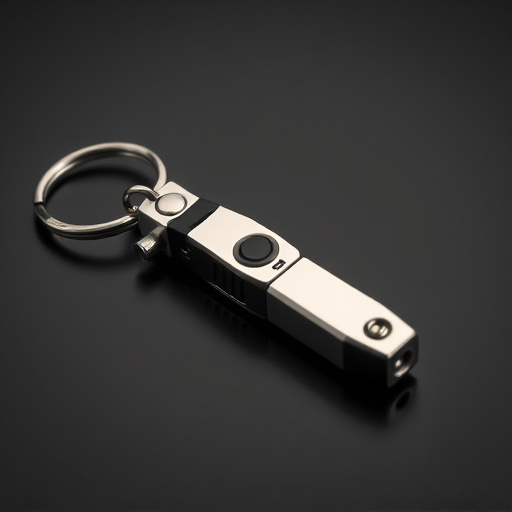Tactical keychains provide enhanced security with built-in tools like knives, flashlights, and screwdrivers, but their legality varies by region. Users must research local laws and adhere to the Prohibited Keychain Weapons List to avoid legal issues. Ideal self-defense keyrings offer quick deployment, multiple defense options, durability, and compliance with legal standards for peace of mind.
“Unleash your personal safety with the ultimate self-defense tool—the tactical keyring. This compact defense mechanism has gained popularity for its strategic design and ease of access. In this comprehensive guide, we’ll unravel the secrets of tactical keychain designs, exploring their legal boundaries and essential features.
From understanding the difference between a handy keychain and a prohibited weapon to discovering top self-defense options, this article covers everything. Learn which keyring traits make them effective and navigate the legal considerations surrounding these innovative personal defense tools, including the Prohibited Keychain Weapons List.”
- Understanding Tactical Keychain Designs: A Brief Overview
- Legal Considerations: What Constitutes a Prohibited Keychain Weapon?
- Key Features of an Effective Self-Defense Keyring
- Exploring Popular Self-Defense Keyring Options and Their Unique Selling Points
Understanding Tactical Keychain Designs: A Brief Overview
Tactical keychain designs are a unique and often overlooked category in the world of self-defense tools. These compact devices are engineered to provide individuals with an extra layer of security and protection, especially when out and about. A tactical grip keyring combines the functionality of a standard keychain with enhanced features for self-defense purposes. It is designed to be more than just a way to carry your keys; it aims to deter potential attackers and offer a means of escape or defense in emergency situations.
Understanding the design involves recognizing that these keychains are not your typical, everyday accessories. They often include features like a built-in edge weapon (such as a knife or glass breaker), a flashlight, and various tools like screwdrivers or hooks. Some even have tactical grips for better control and comfort during use. It’s essential to note that while these designs can be useful, there are legal restrictions on what constitutes a prohibited keychain weapon, with many regions having specific laws regarding the carrying of such devices. Therefore, it’s crucial to check local regulations before considering acquiring one, especially as some may fall under the category of restricted or illegal weapons.
Legal Considerations: What Constitutes a Prohibited Keychain Weapon?
When considering self-defense tools, it’s crucial to understand the legal implications and what constitutes a prohibited keychain weapon varies by jurisdiction. In many regions, certain objects designed or capable of causing harm are illegal to carry, especially if they can be easily concealed on a keyring. This includes items like tactical grips with hidden blades or sharp edges, which might look like everyday keychains but could be deemed as dangerous weapons.
The ‘prohibited keychain weapons list’ typically includes any device that can inflict serious physical harm, such as knifes, razor blades, or sharp objects designed for combat. It’s essential to research and comply with local laws and regulations to avoid legal consequences. Staying informed about these restrictions ensures responsible ownership and safe usage of self-defense tools, especially in public spaces.
Key Features of an Effective Self-Defense Keyring
When considering a self-defense keyring, several key features set apart effective tactical designs from mundane tools. First and foremost, the ability to deploy quickly and quietly is paramount. A smooth, reliable mechanism ensures that every second counts in high-stress situations. Additionally, the keyring should offer multiple defense options; this could include embedded sharp edges, non-lethal force tools like pepper spray dispensers, or even noise makers to startle aggressors.
Durability and reliability are also critical factors. The keyring must withstand routine wear and tear, as well as extreme conditions like impact, pressure, and exposure to the elements. Moreover, it should adhere to legal requirements; understanding the Prohibited Keychain Weapons List is essential to ensure your chosen tool does not violate local or state laws. A well-designed tactical keyring balances functionality with legality, providing a reliable personal defense option for individuals seeking peace of mind.
Exploring Popular Self-Defense Keyring Options and Their Unique Selling Points
In the ever-evolving landscape of personal safety, self-defense keyrings have emerged as a compact and tactical solution for individuals seeking to protect themselves in various situations. These innovative tools offer a unique blend of functionality and design, catering to those who want to be prepared but prefer a discreet approach. When exploring popular options, one quickly encounters a diverse range of features and materials, each with its own distinct advantages.
The market is flooded with self-defense keyrings that boast unique selling points, from robust construction for impact resistance to integrated flashlights or sharp blades designed to deter attackers. Some models even incorporate pepper spray or noise makers to startle potential threats. However, it’s crucial to be mindful of local laws and the Prohibited Keychain Weapons List, ensuring that the chosen defense mechanism complies with legal boundaries. This careful consideration ensures that individuals can leverage these compact tools effectively while staying within the confines of the law.
When considering a self-defense keyring, understanding the legal implications of prohibited keychain weapons is vital. Knowing what constitutes a tactical keychain within your region ensures you stay on the right side of the law. Effective self-defense tools should be designed with ergonomic grip and reliable mechanisms in mind. By exploring popular options, you can find a compact, yet powerful solution for personal safety, without carrying traditional weapons that might fall into prohibited keychain weapons lists.
